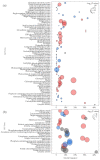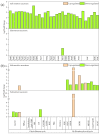Transcriptome Analysis Reveals Molecular Mechanisms under Salt Stress in Leaves of Foxtail Millet (Setaria italica L.)
- PMID: 35890498
- PMCID: PMC9323065
- DOI: 10.3390/plants11141864
Transcriptome Analysis Reveals Molecular Mechanisms under Salt Stress in Leaves of Foxtail Millet (Setaria italica L.)
Abstract
Foxtail millet (Setaria italica L.) is an important cereal for managing future water scarcity and ensuring food security, due to its strong drought and salt stress resistance owing to its developed root system. However, the molecular responses of foxtail millet leaves to salt stress are largely unknown. In this study, seeds of 104 foxtail millet accessions were subjected to 0.17 mol·L-1 NaCl stress during germination, and various germination-related parameters were analyzed to derive 5 salt-sensitive accessions and 13 salt-tolerant accessions. Hong Gu 2000 and Pu Huang Yu were the most salt-tolerant and salt-sensitive accessions, respectively. To determine the mechanism of the salt stress response, transcriptomic differences between the control and salt-treated groups were investigated. We obtained 2019 and 736 differentially expressed genes under salt stress in the salt-sensitive and salt-tolerant accessions, respectively. The transcription factor families bHLH, WRKY, AP2/ERF, and MYB-MYC were found to play critical roles in foxtail millet's response to salt stress. Additionally, the down-regulation of ribosomal protein-related genes causes stunted growth in the salt-sensitive accessions. The salt-tolerant accession alleviates salt stress by increasing energy production. Our findings provide novel insights into the molecular mechanism of foxtail millet's response to salt stress.
Keywords: DEGs; RNA; foxtail millet; salt stress; salt tolerance identification; transcriptome.
Conflict of interest statement
The authors declare that the research was conducted in the absence of any commercial or financial relationships that could be construed as a potential conflict of interest.
Figures





Similar articles
-
Mechanisms of Salt and Drought Stress Responses in Foxtail Millet.Plants (Basel). 2025 Apr 15;14(8):1215. doi: 10.3390/plants14081215. Plants (Basel). 2025. PMID: 40284101 Free PMC article. Review.
-
Transcriptome and metabolite analysis reveal the drought tolerance of foxtail millet significantly correlated with phenylpropanoids-related pathways during germination process under PEG stress.BMC Plant Biol. 2020 Jun 15;20(1):274. doi: 10.1186/s12870-020-02483-4. BMC Plant Biol. 2020. PMID: 32539796 Free PMC article.
-
Genome-Wide Gene Expression Profiles Analysis Reveal Novel Insights into Drought Stress in Foxtail Millet (Setaria italica L.).Int J Mol Sci. 2020 Nov 12;21(22):8520. doi: 10.3390/ijms21228520. Int J Mol Sci. 2020. PMID: 33198267 Free PMC article.
-
Genome-wide investigation and expression profiling of AP2/ERF transcription factor superfamily in foxtail millet (Setaria italica L.).PLoS One. 2014 Nov 19;9(11):e113092. doi: 10.1371/journal.pone.0113092. eCollection 2014. PLoS One. 2014. PMID: 25409524 Free PMC article.
-
Transcriptome analysis and identification of the low potassium stress-responsive gene SiSnRK2.6 in foxtail millet (Setaria italica L.).Theor Appl Genet. 2024 Jan 16;137(1):22. doi: 10.1007/s00122-023-04532-6. Theor Appl Genet. 2024. PMID: 38227064 Review.
Cited by
-
Allelopathic Effects of Corn Straw and Its Water Extracts on Four Weed Species and Foxtail Millet.Plants (Basel). 2024 May 10;13(10):1315. doi: 10.3390/plants13101315. Plants (Basel). 2024. PMID: 38794386 Free PMC article.
-
Synergistic effect of carbon nanoparticles with mild salinity for improving chemical composition and antioxidant activities of radish sprouts.Front Plant Sci. 2023 May 31;14:1158031. doi: 10.3389/fpls.2023.1158031. eCollection 2023. Front Plant Sci. 2023. PMID: 37324721 Free PMC article.
-
Foxtail millet research in supporting climate change resilience efforts: Bibliometric analysis and focused literature review.Heliyon. 2025 Jan 28;11(3):e42348. doi: 10.1016/j.heliyon.2025.e42348. eCollection 2025 Feb 15. Heliyon. 2025. PMID: 39968133 Free PMC article. Review.
-
Mechanisms of Salt and Drought Stress Responses in Foxtail Millet.Plants (Basel). 2025 Apr 15;14(8):1215. doi: 10.3390/plants14081215. Plants (Basel). 2025. PMID: 40284101 Free PMC article. Review.
-
Genomic Analysis of Hexokinase Genes in Foxtail Millet (Setaria italica): Haplotypes and Expression Patterns Under Abiotic Stresses.Int J Mol Sci. 2025 Feb 24;26(5):1962. doi: 10.3390/ijms26051962. Int J Mol Sci. 2025. PMID: 40076588 Free PMC article.
References
-
- Eswaran H., Lal R., Reich P.F. Response to Land Degradation. CRC Press; Boca Raton, FL, USA: 2019. Land degradation: An overview; pp. 20–35.
-
- Zhou J. Expression Profile of miRNA of Populus cathayana Rehd and Salix matsudana Koidz. under Salt Stress. Chinese Academy of Forestry; Beijing, China: 2010.
-
- Ma Y., Wang X.P., Zhang S.F., Shi D.C., Sheng L.X. Effects of salt and alkali stress on growth, accumulation of oxalic acid, and activity of oxalic acid-metabolizing enzymes in kochia sieversiana. Biol. Plant. 2016;60:774–782. doi: 10.1007/s10535-016-0650-2. - DOI
Grants and funding
LinkOut - more resources
Full Text Sources
Research Materials

